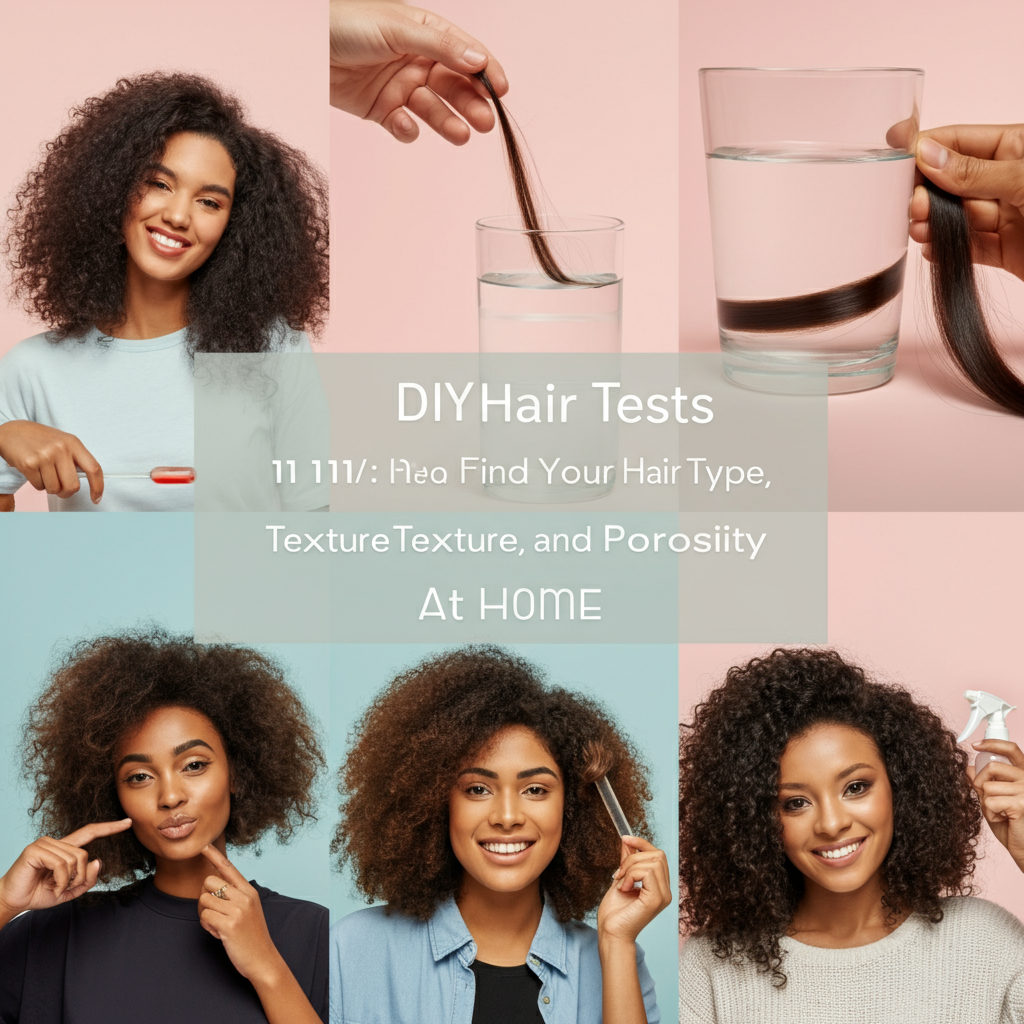
Introduction
Your hair care routine should be as unique as you are. You might be using the most expensive products on the market, but if they aren’t right for your hair’s specific needs, you could be doing more harm than good. The key to unlocking luscious, healthy hair isn’t a secret magic potion; it’s knowledge. Understanding your hair’s fundamental characteristics—its type, texture, and porosity—is the first and most crucial step toward building a routine that works. These simple at-home DIY hair tests will help you finally understand what your hair truly needs to thrive.
This guide will walk you through everything you need to know to perform a complete hair identification test from the comfort of your own bathroom. We will explore why these factors are so important for moisture retention and styling choices, and how they directly impact your hair’s overall health and growth. By the end, you’ll be equipped with the insights to stop guessing and start choosing products and treatments with confidence.
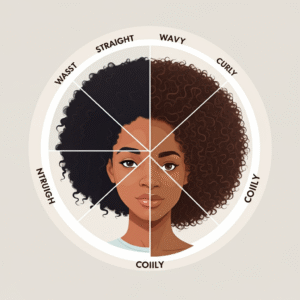
Why Hair Type, Texture, and Porosity Are Game-Changers
Have you ever wondered why a “holy grail” product that your friend swears by leaves your hair feeling greasy or, conversely, still dry and frizzy? The answer lies in the unique combination of your hair’s type, texture, and porosity. These three pillars of hair identity govern everything from how your hair absorbs moisture to how it holds a style.
Hair Type primarily refers to your hair’s curl pattern, which is determined by the shape of your hair follicles. It dictates the natural shape of your strands—whether they grow straight, wavy, curly, or coily—and influences how oils from your scalp travel down the hair shaft. This affects natural moisture levels and how your hair responds to different styling techniques.
Hair Texture describes the thickness or diameter of an individual hair strand. It can be fine, medium, or coarse. Texture impacts how well your hair holds styles and its overall volume. Fine hair, for example, can be easily weighed down by heavy products, while coarse hair might need richer formulas to feel soft and managed.
Hair Porosity is perhaps the most overlooked but most critical factor. It determines how well your hair can absorb and retain moisture. Porosity depends on the structure of your hair’s cuticle, its outermost layer. A tightly bound cuticle indicates low porosity, making it hard for moisture to get in. A raised or damaged cuticle means high porosity, allowing moisture to enter easily but also escape just as quickly. Understanding this is essential for effective frizz management and creating a healthy scalp routine.
When you know these three elements, you can move beyond generic advice and create a custom hair care plan. You’ll be able to select shampoos, conditioners, and styling products that are formulated specifically for your hair’s needs, leading to healthier, more predictable, and more beautiful results.
The 3 Key Elements of Your Hair Profile
Before we dive into the tests, let’s briefly introduce the three core components you’re about to identify. Your final hair profile will be a combination of these characteristics.
- Hair Type: This is the visual pattern of your hair.
- Type 1: Straight
- Type 2: Wavy
- Type 3: Curly
- Type 4: Coily
- Hair Texture: This refers to the thickness of each strand.
- Fine: Thin and delicate strands.
- Medium: The most common texture, not too thin or thick.
- Coarse: Thick, strong strands.
- Hair Porosity: This is about your hair’s ability to absorb moisture.
- Low: Repels moisture.
- Medium: Absorbs and retains moisture well.
- High: Absorbs moisture quickly but loses it fast.
Now, let’s get hands-on with some simple DIY hair tests to uncover your unique profile.
DIY Hair Type Test: Discover Your Natural Pattern
The first step in your hair identification journey is the hair type test. This helps you determine whether your hair is straight, wavy, curly, or coily. For the most accurate results, you need to observe your hair in its most natural state.
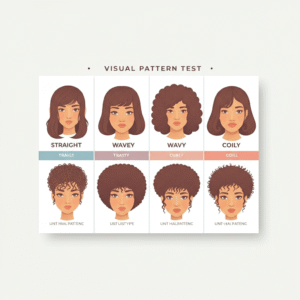
1. The Visual Pattern Test
This is the most straightforward method to find your hair type. It requires nothing more than a gentle wash and some patience.
How to do it:
- Wash and Condition: Start by washing and conditioning your hair as you normally would. Use products that are known to work well for you, but avoid any heavy styling creams or gels for this test.
- Rinse Thoroughly: Make sure all product is rinsed out of your hair.
- Hands Off: Gently scrunch out excess water with a microfiber towel or an old t-shirt to minimize frizz. Do not comb, brush, or apply any leave-in products.
- Air-Dry: Let your hair air-dry completely without touching it. This is crucial, as touching it can disrupt your natural pattern.
- Examine the Results: Once your hair is dry, look in the mirror and observe its natural shape.
Interpreting the Results:
- Straight Hair (Type 1): Your hair falls flat from the roots to the tips without any discernible bend or curl. It often has a natural shine because scalp oils can easily travel down the straight shaft. It may struggle to hold a curl when styled.
- Wavy Hair (Type 2): Your hair has a definite “S” shape. It’s not as oily as straight hair but not as dry as curly hair. Wavy hair can range from loose, beachy waves (Type 2A) to more defined S-shapes (Type 2C). It’s prone to frizz, especially in humid weather.
- Curly Hair (Type 3): You have defined, springy ringlets or spirals that are noticeable from the moment your hair starts to dry. The curls can be loose loops (Type 3A) or tight, corkscrew-like spirals (Type 3C). This hair type is often dry and needs significant moisture.
- Coily Hair (Type 4): Your hair is characterized by very tight curls, zig-zags, or undefined patterns. It may look shorter than it is due to “shrinkage.” Coily hair is the most fragile and driest of all hair types because the tight curl pattern makes it difficult for scalp oils to moisturize the entire length of the strand.
2. The Hair Root Test
For another clue, especially if you’re torn between two types, take a look at your roots.
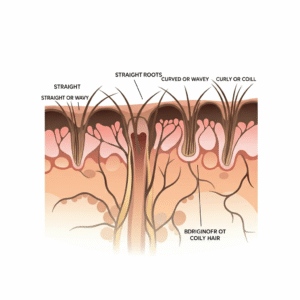
How to do it:
Examine the hair as it grows directly from your scalp. You may need to look closely in a mirror.
- Straight Roots: If the hair emerges from the scalp without any curve, you likely have Type 1 (straight) or Type 2 (wavy) hair.
- Curved Roots: If the hair grows out in a C-shape or a tight coil right from the scalp, you have Type 3 (curly) or Type 4 (coily) hair.
DIY Hair Texture Test: Fine, Medium, or Coarse?
Next up is the hair texture test. This is not about how your hair feels as a whole (e.g., soft or rough), but rather about the physical thickness of a single strand. This test helps you understand if you have fine, medium, or coarse hair.
1. The Strand Thickness Test
This is the quickest and most popular way to determine your hair’s texture.
How to do it:
- Pluck a Strand: Gently pull out a single strand of hair. If you’d rather not pluck, find one that has shed naturally on your clothes or brush.
- Roll It: Take the strand and roll it between your thumb and index finger.
Interpreting the Results:
- Fine Hair: You can barely feel the strand, or it feels silky and almost nonexistent. Fine hair is very delicate and can be prone to breakage.
- Medium Hair: You can feel the strand, but it doesn’t feel overly rough or wiry. It’s substantial but not stiff. This is the most common hair texture.
- Coarse Hair: The strand feels noticeably thick, wiry, and substantial between your fingers. Coarse hair is strong but can also be prone to dryness and a rough feeling.
2. The Thread Comparison Test
If you’re having trouble with the finger-rolling method, this comparison test provides a great visual aid.
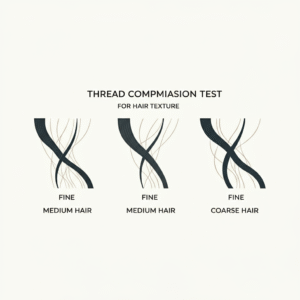
How to do it:
- Get Your Materials: Take a single strand of your hair and a standard piece of sewing thread.
- Compare Side-by-Side: Place the hair strand next to the thread on a flat, contrasting surface (like a white piece of paper).
Interpreting the Results:
- Thinner Than Thread: If your hair strand is significantly thinner than the sewing thread, you have fine hair.
- Same Thickness: If your strand is roughly the same thickness as the thread, you have medium hair.
- Thicker Than Thread: If your strand is noticeably thicker than the thread, you have coarse hair.
It’s important to note that hair density and hair texture are different. Density refers to how many hair strands are on your head, while texture refers to the thickness of each one. You can have fine hair that is very dense, or coarse hair that is thin (low density).
DIY Hair Porosity Tests: The Secret to Moisture Balance
This is the ultimate DIY hair test. Understanding your hair’s porosity is the key to mastering moisture. Porosity is all about your hair cuticle structure and its ability to let moisture in and out. These tests will help you discover if you have low, medium, or high porosity hair. For best results, make sure your hair is clean and completely free of any product.
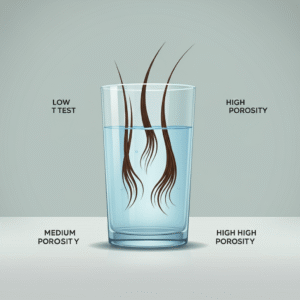
1. The Float Test for Hair
This is the most well-known hair porosity test at home, and for good reason. It provides a clear visual indication of your hair’s porosity level.
How to do it:
- Gather Supplies: You’ll need a clear glass of room-temperature water and a few strands of clean, dry hair.
- Drop the Hair: Place the strands of hair into the glass of water.
- Observe: Watch what happens over the next 2-4 minutes.
Interpreting the Results:
- Hair Floats on Top: If your hair stays floating at the surface after a few minutes, you have low porosity hair. Your hair cuticle is tightly sealed, resisting water absorption.
- Hair Slowly Sinks: If your hair gradually sinks to the middle of the glass, you have medium porosity hair. Your cuticle is healthy and allows moisture to enter and be retained effectively.
- Hair Sinks Quickly: If your hair plummets to the bottom of the glass almost immediately, you have high porosity hair. Your cuticle is raised or has gaps, causing it to soak up water rapidly.
2. The Spray Bottle Test
This test is another great way to see how your hair interacts with water in real-time.
How to do it:
- Isolate a Section: Take a small, clean section of your hair.
- Mist with Water: Using a spray bottle, lightly mist the section with water.
- Watch Closely: Observe how the water behaves on your hair’s surface.
Interpreting the Results:
- Water Beads Up: If you see small water droplets sitting on top of your hair, you have low porosity hair.
- Water Slowly Absorbs: If the water sits for a moment before slowly sinking in, you have medium porosity hair.
- Water Absorbs Immediately: If your hair instantly soaks up the water and feels wet, you have high porosity hair.
3. The Slip Test
This tactile test allows you to feel the condition of your hair’s cuticle layer.
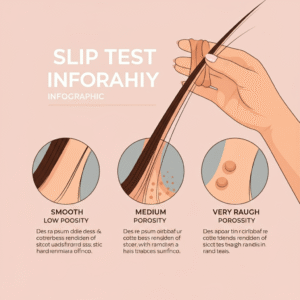
How to do it:
- Isolate a Strand: Take a single strand of hair between your thumb and index finger.
- Slide Upwards: Slide your fingers up the strand, from the tip towards your scalp.
Interpreting the Results:
- Feels Smooth: If the strand feels completely smooth as you slide your fingers up, you have low porosity hair. Your cuticles are flat and tightly packed.
- Feels Slightly Bumpy: If you feel minor bumps or unevenness, you have medium porosity hair. Your cuticles are slightly raised but generally healthy.
- Feels Very Rough and Bumpy: If the strand feels very rough, rigid, and bumpy, you have high porosity hair. Your cuticles are raised and open.
Putting It All Together: Your Personalized Hair Profile
Now that you’ve completed each DIY hair test, it’s time to combine the results to create your full hair profile. This complete picture will be your guide to a truly personalized hair care routine.
For example, you might discover you have:
- Type 4 Coily + Fine Texture + High Porosity: This hair needs intense moisture and gentle handling. The fine texture means it can be weighed down, so while it needs rich moisture due to its high porosity and coily type, the products shouldn’t be excessively heavy. Protein treatments will be crucial to fill the gaps in the cuticle.
- Type 2 Wavy + Coarse Texture + Low Porosity: This hair type is resistant to moisture. It needs lightweight, water-based products that can penetrate the tight cuticle. Steam treatments or using a heated cap during deep conditioning can help products absorb better. The coarse texture can handle richer creams once the moisture is in.
- Type 1 Straight + Fine Texture + Low Porosity: This hair is prone to product buildup and can easily look greasy. It requires lightweight, volumizing products and regular clarifying to keep it from getting weighed down.
Here is a quick reference chart to help you get started:
|
Hair Profile Example |
Key Challenges |
Care Focus |
|---|---|---|
|
Curly, Fine, High Porosity |
Frizz, Breakage, Lacks Volume |
Lightweight hydration, protein, gentle styling |
|
Straight, Coarse, Low Porosity |
Dryness, Product Buildup |
Clarifying, heat-assisted conditioning, hydrating oils |
|
Wavy, Medium, Medium Porosity |
Inconsistency, Mild Frizz |
Balanced moisture and protein, curl-enhancing creams |
What Each Result Means for Your Hair Care Routine
Let’s break down what each specific trait needs so you can start making smarter choices.
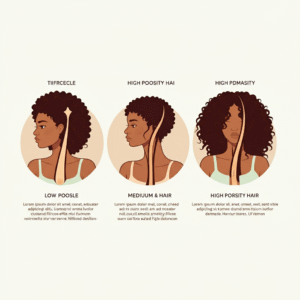
1. Low Porosity Hair Care
- Characteristics: Hair is resistant to moisture, takes a long time to get fully wet, and is prone to product buildup because products sit on top of the hair instead of absorbing.
- Care Focus: The goal is to get moisture into the hair shaft. Use lightweight, water-based products like milks and lotions. Look for humectants like glycerin or aloe vera that attract moisture. Applying gentle heat with a steamer or a heated deep conditioning cap can help open the cuticle and allow treatments to penetrate. Clarify regularly to remove buildup.
2. High Porosity Hair Care
- Characteristics: Hair absorbs moisture instantly but loses it just as fast, leading to chronic dryness and frizz. It often feels brittle and is prone to breakage. This can be genetic or a result of chemical damage.
- Care Focus: The goal is to both moisturize and seal. Layering products is key. Use a leave-in conditioner, followed by a cream, and finally an oil to seal everything in (L.C.O. method). Regular protein treatments are essential to repair gaps in the cuticle. Avoid very hot water, which can raise the cuticle further.
3. Fine Hair Care
- Characteristics: Strands are thin and delicate, making the hair prone to breakage and easily weighed down by heavy products. It often lacks volume.
- Care Focus: Choose lightweight products that offer volume and strength. Volumizing mousses, sprays, and light conditioners are your best friends. Avoid heavy butters and oils, especially near the roots. Protein treatments can also help strengthen the delicate strands.
4. Coarse Hair Care
- Characteristics: Strands are thick and strong but can feel wiry, dry, and rough. This texture is often resistant to styling and needs a lot of moisture to feel soft.
- Care Focus: Deep moisture is non-negotiable. Rich, creamy deep conditioners, hydrating masks, and butters like shea or mango butter work well. Anti-frizz serums and oils can help smooth the cuticle and add shine.
Common Mistakes to Avoid
Now that you’re armed with this knowledge, be sure to avoid these common hair care mistakes:
- Using heavy oils on low porosity hair: This will only cause greasy buildup. Stick to lighter oils like grapeseed, argan, or jojoba oil.
- Confusing density with texture: Don’t assume that because you have a lot of hair (high density), it’s coarse. If your strands are fine, you still need lightweight products.
- Skipping protein on high porosity hair: Moisture alone isn’t enough. Protein provides the structure to hold that moisture in. Look for products with hydrolyzed proteins.
- Applying products to soaking wet hair with low porosity: Squeeze out excess water first. If your hair is already saturated with water, there’s no room for the product to penetrate.
Conclusion: Your Journey to Healthier Hair Starts Now
Knowing your hair is the most powerful tool in your beauty arsenal. By taking a few minutes to perform these simple DIY hair tests, you’ve unlocked the personalized information needed to build a hair care routine that delivers real results. Say goodbye to the frustrating cycle of trial and error and hello to hair that is healthier, more manageable, and more beautiful than ever.
Use your new hair profile—your combination of type, texture, and porosity—to confidently select the right products and treatments. Your hair will thank you for it.
Frequently Asked Questions (FAQs)
Q: How accurate are these DIY hair tests?
A: DIY hair tests are a great starting point and are generally accurate enough to guide your product choices. The float test, for instance, provides a reliable visual. However, factors like water hardness can slightly affect results. It’s best to perform a few different tests (e.g., float test and spray test) to confirm your porosity.
Q: Can my hair type or porosity change over time?
A: Your fundamental hair type (straight, wavy, etc.) is genetically determined and won’t change. However, your hair’s porosity can and will change. Chemical treatments (dye, bleach, relaxers), heat damage, and even environmental exposure can increase your hair’s porosity. Conversely, by using restorative treatments, you can improve the health of your cuticle, effectively lowering high porosity.
Q: Does age affect my hair?
A: Yes. As we age, hormonal changes can affect hair texture and density. Many people find their hair becomes finer, drier, and more fragile over time, which may require adjustments to their hair care routine.





Leave a Reply